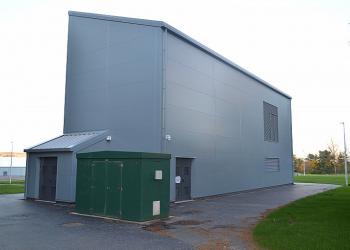Redeveloping the Regional Performance Centre for Sport at Caird Park, Dundee includes an innovative Low Carbon District Energy Hub that utilises surrounding green space to provide energy for the buildings on-site with potential for off-site supply.

Dundee City Council
Go To WebsiteAddressed Challenges:
Action Areas:
- Energy
- Built Environment
Initiative Purpose:
- Mitigation
The Story

Redevelopment of the Regional Performance Centre for Sport at Caird Park, Dundee includes an innovative Low Carbon District Energy Hub that utilises surrounding green space to provide energy for the buildings on-site with potential for off-site supply in the future.
Caird Park is a 111 ha park to the north of Dundee city centre. It is well used for active recreation offering facilities such as a golf course, a velodrome and athletic tracks. Dundee City Council and sportscotland created a new Regional Performance Centre for Sport which includes a Low Carbon District Energy Hub (LCDEH) utilising Low or Zero Carbon Technologies. The energy hub is part of a bigger redevelopment of the site, where previous buildings have been demolished to be replaced by new, more energy efficient buildings.
The LCDEH in Caird Park combines multiple green energy technologies. A 600kW Ground Source Heat Pump (GSHP) solution was installed based on 116 vertical boreholes, mostly 200m deep and 12m apart, arranged in a square grid pattern. This extracts ’low grade’ heat (circa 8°C to 10°C) from below ground and convert this into a higher grade heat (70°C), which then becomes useful in providing the heat demands of the various buildings. This is achieved using a heat pump which runs on electricity, and for every 1kW of electrical energy consumed, it produces 3.6kW of heat energy, due also to the heat obtained from below the ground.
Thermal conductivity testing was undertaken at three locations before finalising the borehole design. It was expected that all boreholes would be drilled to 200m depth but in a small number of cases the vertical drilling hit fractured rock limiting the drilling depth. For these, their depth was reduced to 100m and, to offset this, additional 12 boreholes were added.
Due to the differential costs of gas (3p/kWh) verses electricity (11.3p/kWh), a Combined Heat and Power (CHP) unit is used to generate the electricity that is required to run the heat pumps. This enables the project to benefit from the significantly cheaper cost of gas, whilst using electrically powered heat pump units. The CHP unit will also contribute valuable heat to the system.
Lastly, solar thermal panels, mounted on the Energy Centre’s roof, and solar PV panels, mounted on the Performance Hub’s roofs, boost hot water and electricity generation for use in the buildings. On-site gas boilers will be available for back-up heat generation if needed at peak periods.
Success & Outcomes
The benefits of district heating in Dundee as an effective way of making the most of our heat resources are recognised. Greater opportunity exists for expansion to create large-scale integrated heat networks that will generate real social, economic and environmental benefits for the city through tackling fuel poverty, creating new jobs and reducing our carbon emissions.
Advice for others looking to do something similar
The Dundee Partnership identified District Heating as a strategic priority within their city-wide District Heating Strategy that examines the development of a number of linked district energy centres in Dundee. This project represents Phase 1 of the Partnership’s ambitions and it is anticipated it will act as the catalyst to accelerate the development of the other district heating priority projects that will eventually form a city-wide energy network. In doing so, the project is expected to significantly contribute to the transformational change in our energy use by reducing demand and encouraging local generation through investment in infrastructure that will deliver a long-term affordable, low carbon heat supply and tackle fuel poverty.

